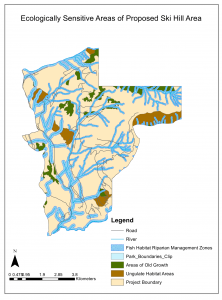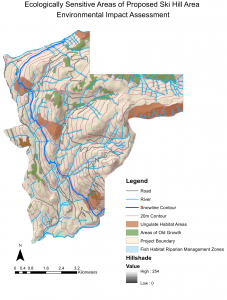MEMORANDUM
From: Shakti Ramkumar
To: City of Squamish
Subject: Environmental Impact Assessment of Proposed Garibaldi Ski Resort
I have reviewed the Garibaldi at Squamish project, and have put together a summary of my analysis and a set of recommendations to guide decisions on whether this proposal should proceed.
Summary of Analysis
The BC Environmental Office stated that the project lacked information on potential effects on vegetation, fish and wildlife habitat. In order to address this gap, I analyzed the extent to which the proposed project area would impact protected old growth forest, riparian fish habitat, and wildlife habitat, with a specific focus on ungulates. The data used was acquired through DataBC’s open catalogue. Unreliable skiing areas, as defined by the Municipality of Whistler, were also considered.
First, I mapped the areas within the project boundary that fell within 555m elevation, as areas below this elevation are considered unreliable skiing areas due to climatological considerations. Then, I mapped old growth management areas and ungulate habitat onto the project area. I also created variable buffer zones around rivers within the project boundary to evaluate what percentage of the proposed project area fell within fish bearing streams and fish habitat surrounding streams. (See below for maps.)
Results
I discovered that 38.26% of the project area may impact old growth forest, ungulate habitat, and riparian fish habitat. Note that the following individual percentages sum to 42.69% of the project area, as some of the areas below may overlap.
- Old growth forest: 6.78%
- Ungulate winter habitat: 7.89&
- Mule Deer habitat: 4.24%
- Mountain Goat habitat: 3.65%
- Sensitive fish habitat: 02%
In addition to vegetation and wildlife impact, I found that 29.92% of the project area is at or below 555m elevation.
Maps
Left: Ecologically Sensitive Areas of Proposed Skil Hill Area (without hillshade)
Right: Ecologically Sensitive Areas of Proposed Skil Hill Area (with 3D hillshade)
Recommendations
The following are recommendations to sufficiently address the two main concerns facing the project.
1. Nearly a third (29.92%) of the proposed project site falls within what is defined by the Municipality of Whistler to be ‘unreliable skiing areas’, as these areas may potentially not get enough snow to support skiing. With climate change bringing warmer and more unpredictable winter conditions, this must be seriously considered.
Actions:
- Restrict construction of ski runs and villages to areas situated above 555m elevation.
- Conduct further analysis to identify areas which may not receive sufficient snowfall, and close these areas when ski conditions are unreliable.
2. Nearly 40% of the proposed project site contains sensitive old growth forest or wildlife and fish habitat.
Actions:
- Note that much of these sensitive ecological areas do overlap with areas below 555m, which means that ecological impact could be minimized by careful planning to ensure that construction takes place well above 555m, thereby also avoiding the majority of the sensitive ecological areas.
- Shifting wildlife habitat due to climate change: It is also important to note that with changing climate, ungulates’ winter range could shift to include areas at or above 555m elevation, so further analysis using climate modelling is advised.
- Fish habitat buffer zones: Avoid building ski runs within a 50m buffer zone around streams in areas above 555m elevation, and within a 100m buffer zone around streams in areas below 555m. Also avoid construction near major tributaries and spawning grounds, as impacting these areas can have significant downstream effects on fish and fish habitat.
- Human impact after construction: Clear public signage notifying visitors of off-bounds areas and ongoing enforcement of these rules is required to minimize ecological impact, so consider whether the Garibaldi at Squamish project proposal includes budget and resources allocated to these management processes.
If the above recommendations are implemented, and further analysis is conducted to predict the impact of climate change on wildlife habitat and changing snow patterns, the concerns outlined by the BC Environmental Assessment Office may be adequately addressed.
Accomplishment Statement
In this lab, I conducted a small Environmental Impact Assessment of a proposed ski resort. After studying Canada’s EIA process and related policies in great depth in GEOG 319, I was excited to be able to implement part of the process myself using available datasets. Upon acquiring datasets from the BC Government’s DataBC database, I queried for red listed species and old growth forest ecosystems to highlight them on the map. I also reclassified a Digital Elevation Model raster to show areas that are suitable and unsuitable for skiing. Upon completing my environmental impact assessment, I produced an additional map that shows the topography of the proposed ski resort region with a 3D hillshade. Finally, I summarized my EIA process and findings in an accessible memo written to convey key information to non-technical decision-makers and members of the general public.


